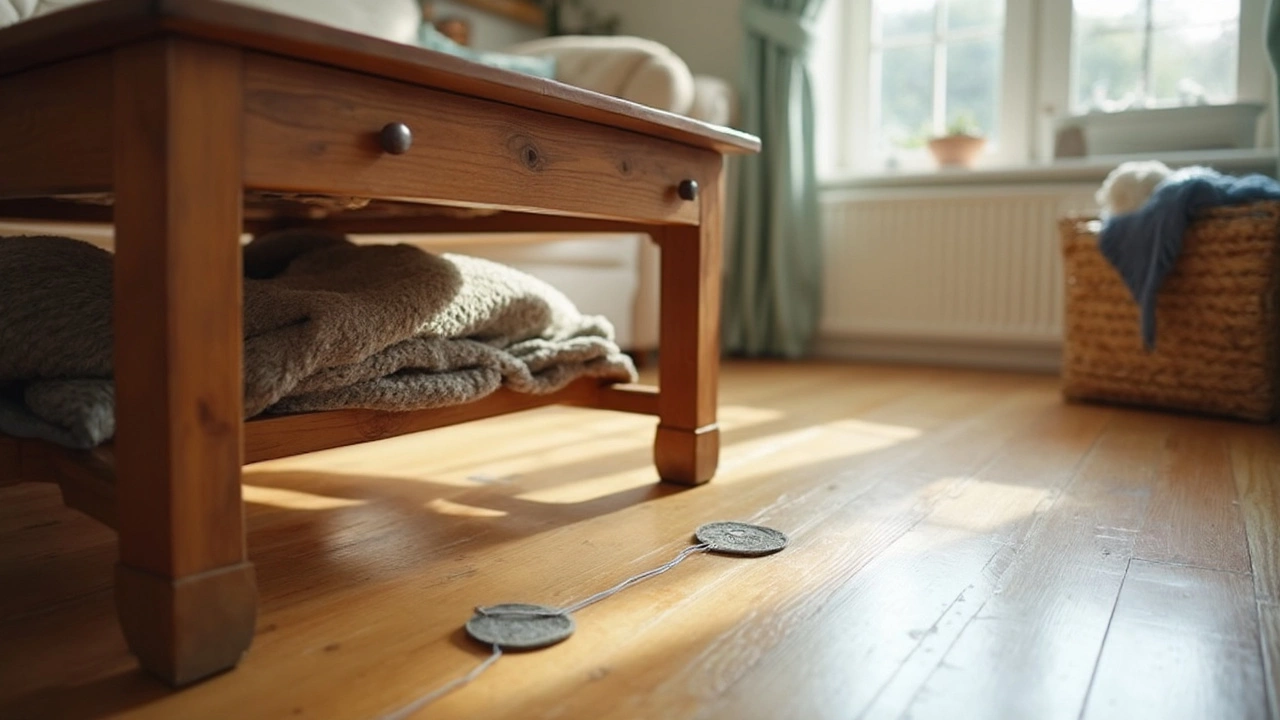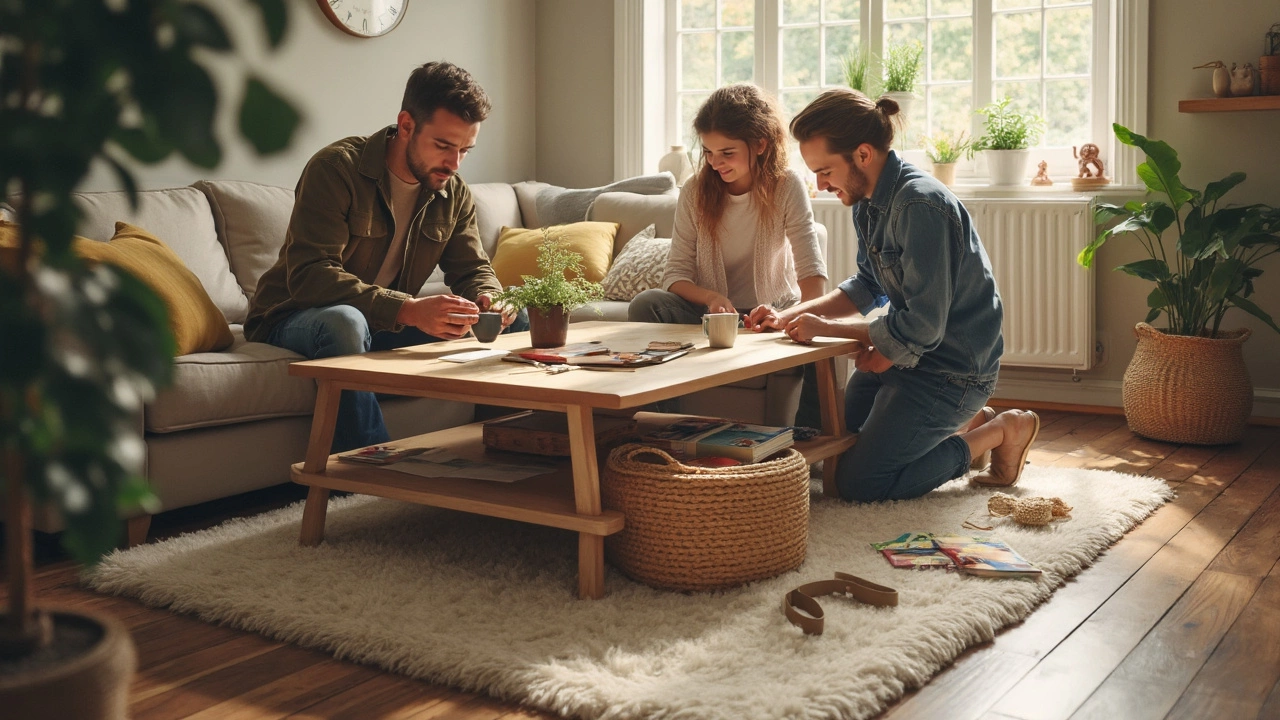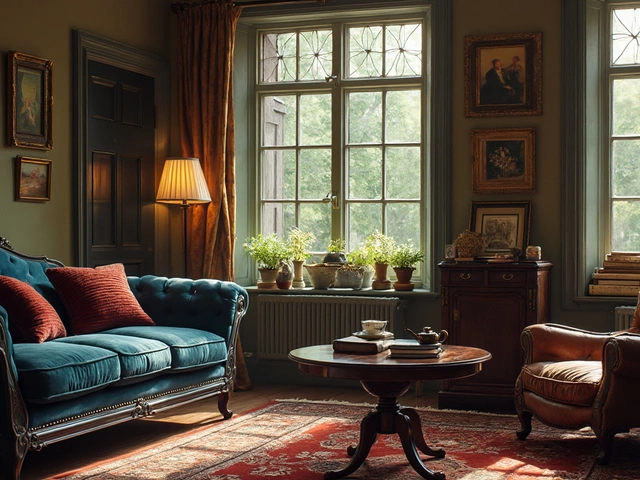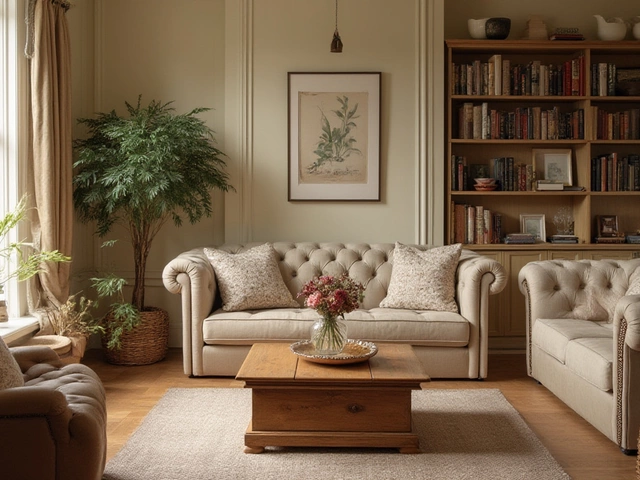 9
Jun,2025
9
Jun,2025
If you’ve ever moved your coffee table and seen a scratch carved into your floor, you know the pain. Most people forget about the bottom of the table, but it’s where smart choices can save you a headache (and money on floor fixes).
Start with the basics: furniture pads stick right onto each leg and seriously cut down on scraping. There’s the standard felt kind, but there are also softer rubber ones. Your floors will thank you, whether you’ve got hardwood, tile, or even carpet that likes to bunch up. And if your table’s a slider, non-slip pads stop it from shifting every time someone puts their feet up or bumps it running past. Super cheap fix, big improvement—just peel and stick.
- Why Worry About the Bottom?
- Furniture Pads & Feet: Your First Defense
- Non-Slip Solutions (So No More Sliding Around)
- Making More Space: Bottom Shelves and Baskets
- Tech Upgrades: Charging Outlets and Hidden Storage
- Personal Style Moves: Rugs, Paint, and DIY Touches
Why Worry About the Bottom?
Most people only think about the top of the table—putting down drinks, stacking books, or setting up a stylish tray. But what’s hiding underneath is just as important. The bottom of your coffee table is where trouble starts if you ignore it. We’re talking about scratched floors, annoying wobbles, and even safety issues if the table’s not steady.
If you move your table a lot—maybe to vacuum or just to rearrange—it acts like sandpaper against your floor. Real numbers: The National Wood Flooring Association says tiny scratches from furniture cause about 25% of floor damage calls they get. That’s not a small deal if you want floors to stay looking good.
- Coffee table legs with no padding will leave marks on hardwood and vinyl, sometimes in a single drag.
- Carpet isn’t safe either—heavy tables that sit in one spot can leave dents you never get out.
- Uneven legs, especially on older tables, lead to rocking or tipping. That’s no fun if you’ve got little kids or hot mugs around.
And if you’re renting? A gouge in a hardwood floor could mean losing part of your deposit. Even if you own, fixing damage costs way more than a few sticky pads or a set of feet.
| Problem | Common Cause | Fix Cost (avg.) |
|---|---|---|
| Scratched floors | No pads/pads worn out | $100-500 (floor repair) |
| Table wobble | Uneven legs or worn feet | $0-10 (pads or feet) |
| Carpet dents | Heavy table, no bottom protection | Permanent, no good fix |
The bottom line: pay attention to the underside of your table now, and you dodge repairs, replacements, and headaches later.
Furniture Pads & Feet: Your First Defense
It sounds simple, but the pads and feet on the bottom of your coffee table are game changers. They’re not just for looks—these little guys can stop scratches, cracks, and wobbles. Most modern coffee tables come with something on the bottom, but it’s usually cheap plastic. Upgrading is worth it.
Felt pads are the go-to for anyone with hardwood or laminate. They’re soft, almost invisible, and easy to swap if they get squished down. For tile or stone, grab rubber pads. These have extra grip and keep the table from sliding every time someone leans on it. Even serious home stores sell universal sets, but don’t expect one-size-fits-all: double check the shape and size to match your table legs. If you have a heavy glass or marble-topped table, you’ll need thicker pads—lighter tables can use slim ones. Here’s a quick look at which pads fit which floors:
| Pad Type | Best For | Average Cost (Set of 16) |
|---|---|---|
| Felt Pads | Hardwood, Laminate | $7 - $12 |
| Rubber Pads | Tile, Stone, Vinyl | $8 - $15 |
| Plastic Sliders | Carpet, Rugs | $6 - $10 |
| Thick Foam Pads | Heavy tables on any surface | $12 - $20 |
More high-end or vintage coffee tables often have actual "feet"—little metal or wooden domes at the end of each leg. They’re pretty sturdy, but they’re not magic. You can pop a pad underneath for extra insurance, or swap in screw-on feet with built-in padding if your table doesn’t have them already. For a truly steady table, check if the feet are adjustable. Uneven floors and wobbly tables go hand-in-hand. Adjustable feet let you tweak each corner so everything sits right.
Bottom line—don’t skip this step. It doesn’t take much time or money, and your coffee table (and your floors) stay looking new way longer.
Non-Slip Solutions (So No More Sliding Around)
If your coffee table turns into a curling stone every time you lean on it, you’re definitely not alone. Most coffee tables aren’t that heavy, and smooth flooring just makes the problem worse. No one wants to chase their table across the room every time a drink goes down on it.
Good news—there’s a pretty simple fix. Non-slip pads do exactly what they sound like: they give your table some grip, so it stays put. You can find rubber gripper pads in home stores or online. The best part? You don’t need any tools—just peel and press them onto each table foot. For round or oddly-shaped feet, cutting the pads down is easy with basic scissors.
Here’s a quick rundown of popular non-slip options for your coffee table:
- Rubber grip pads: These are thick, durable, and handle the job even with heavier tables.
- Clear silicone pads: Blend in nicely if you don’t want something noticeable under your table.
- Non-slip furniture feet: Replace the whole foot with a rubber-tipped one—especially useful if the table slides a lot or you have kids/pets running around.
Let’s see what actually works, by looking at material types and benefits:
| Material | Grip Level | Works With | Durability |
|---|---|---|---|
| Rubber | High | All floor types | Long-lasting |
| Silicone | Medium-High | Hardwood, tile, laminate | Good |
| Felt (not non-slip) | Low | Only carpeted floors | Medium |
If you want an extra strong hold, some pads have adhesive backing on both sides: one sticks to the table foot, the other to the floor. Just be careful—they can leave a mark if you ever want to move things around later.
Little things make a big difference. Just adding the right coffee table pad keeps your setup looking clean, keeps your floor in top shape, and means you’ll never have to awkwardly reposition the table during movie night.

Making More Space: Bottom Shelves and Baskets
Let’s face it: a coffee table isn’t just for resting your mug or remote. The bottom area can turn wasted space into a storage workhorse. Adding shelves or baskets under your table is a game changer, especially in smaller living rooms where every inch counts.
Plenty of modern coffee tables are actually built with a bottom shelf baked right in. It’s not just for show—according to a 2024 survey from Houzz, over 55% of coffee table buyers specifically look for extra storage space below. That shelf might hold your stack of magazines, video game controllers, or even board games.
If you’re working with an open-bottom table, baskets are the easier upgrade. Grab a few bins that fit the space and slide them under. You can stash blankets, chargers, kids’ toys, or that stack of mail you’re pretending you’ve sorted. No tools required.
- Look for baskets or bins at least 2 inches shorter than the space under your table, so you don’t have to force them in and out.
- Wire baskets are great if you want to spot what’s inside quickly. Fabric ones hide clutter better.
- Try sliding trays for board games or laptops—easy to pull out when you need them.
If you’ve ever visited an IKEA, you know the obsession with hacking more storage. Even for a table without a bottom shelf, you can attach a simple wooden board or pre-made shelf from the hardware store. Just screw it in under the top, keep it flush with the legs, and you’ve got extra space for less than $15.
| Storage Option | Typical Cost Range (USD) | Best For |
|---|---|---|
| Shelves (built-in or added) | $15-$40 | Books, decor, large items |
| Fabric Baskets | $10-$25 | Clutter, toys, electronics |
| Wire Baskets | $12-$30 | Magazines, remotes, visible items |
| Sliding Trays | $18-$35 | Laptops, board games, documents |
Bottom shelves and baskets don’t just keep your stuff tidy—they’re a quick way to trick guests into thinking your living room’s always that organized. You’ll wonder why you ever settled for wasted space before.
Tech Upgrades: Charging Outlets and Hidden Storage
Lots of modern coffee tables now come with charging stations tucked away at the bottom. No more hunting for that wall outlet or untangling power cords every time your phone hits 5%. Some tables even have built-in USB ports or full outlets set right underneath—easy to reach, but out of sight if you don’t want cables all over your living room.
Here’s what makes a charging station at the bottom of your table actually useful:
- Charge multiple devices (phones, tablets, even a laptop) at once.
- Reduce tripping hazards by keeping cords off the floor.
- Upgrade old tables using an under-mounted power strip—just screw one underneath and use cable clips to keep things tidy.
If you’re going DIY, stay safe—look for strips or USB hubs with built-in surge protection. A wireless charging pad can also stick to the lower shelf or underside with double-sided tape and will work for most newer phones.
Hidden storage is another game changer. Look for tables with drawers or lift-up tops—there’s usually a secret spot below for remotes, chargers, headphones, or even snacks. Some coffee tables offer storage bins built into the bottom, so they stay out of the way but super easy to grab.
Here’s a quick rundown of what people stash in that bottom space, based on a 2024 survey from Home Upgrade Digest (sample size: 1,200 coffee table owners):
| Item Stored | People Who Do It (%) |
|---|---|
| Phone chargers & power banks | 61 |
| Remote controls | 54 |
| Magazines/books | 35 |
| Board games | 19 |
| Snacks | 8 |
So if you’re looking for ways to really get the most out of your coffee table, think beyond just surface style. Tucking in smart tech or sneaky storage at the bottom turns your table into something that actually makes living easier. It’s practical, hidden, and surprisingly easy to add to most tables with a few basic tools.
Personal Style Moves: Rugs, Paint, and DIY Touches
Turning the bottom of your coffee table into something that matches your vibe is simpler than it sounds. Plenty of people use area rugs not just under the table, but right around the legs. This adds color and texture, protects your floors, and gives off a cozy, finished look. A good trick? Pick a rug that’s about two feet wider and longer than your table, so you don’t get those awkward half-on, half-off corners.
Paint’s another go-to for a quick style boost. You can paint just the bottoms or feet for a color pop, or go for the whole underside if your table sometimes gets flipped or you’re just into that kind of detail. Chalk paint is super forgiving for beginners because it usually skips the sanding and priming steps. In 2024, a furniture industry survey found that 48% of DIY-ers who updated tables tried painting the legs a bold color, and most got more compliments on that than any fancy centerpiece.
If you’re into the DIY scene, baskets and storage bins are an easy add under open-shelf coffee tables. Pick woven ones for a natural look, or clear bins so you always see what’s inside—snack stash, remotes, magazines, kid toys, you name it. Velcro can keep baskets from sliding when you grab stuff out.
- coffee table coasters underneath add a protective and stylish touch, especially if you place them in a small tray for guests to grab easily.
- Try peel-and-stick dividers if you want quick storage without screwing anything in. Most cost under $10 and take just minutes to set up.
- Adding decals or stencils to the bottom wood or glass (the unseen parts) is becoming popular—gives you hidden character that only shows when you move things around.
Here’s a quick glance at how people are making their coffee table bottoms stand out based on a home survey last year:
| Style Move | Popularity (%) | Avg. Cost (USD) |
|---|---|---|
| Area Rug | 61 | 80 |
| Painted Legs | 48 | 15 |
| Baskets/Bins | 37 | 25 |
| Decals/Stencils | 19 | 7 |
Don’t overthink it. Combine one or two of these, and the space under your table goes from being dead space to part of your room’s style—practical and personal at the same time.




